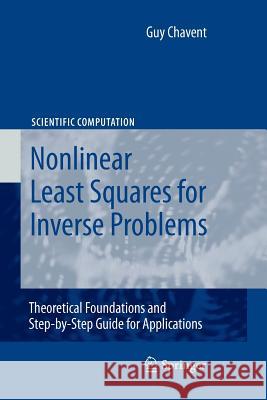Nonlinear Least Squares for Inverse Problems: Theoretical Foundations and Step-By-Step Guide for Applications » książka
Nonlinear Least Squares for Inverse Problems: Theoretical Foundations and Step-By-Step Guide for Applications
ISBN-13: 9789400730601 / Angielski / Miękka / 2012 / 360 str.
Nonlinear Least Squares for Inverse Problems: Theoretical Foundations and Step-By-Step Guide for Applications
ISBN-13: 9789400730601 / Angielski / Miękka / 2012 / 360 str.
(netto: 421,70 VAT: 5%)
Najniższa cena z 30 dni: 424,07
ok. 22 dni roboczych.
Darmowa dostawa!
This book provides an introduction into the least squares resolution of nonlinear inverse problems. The first goal is to develop a geometrical theory to analyze nonlinear least square (NLS) problems with respect to their quadratic wellposedness, i.e. both wellposedness and optimizability. Using the results, the applicability of various regularization techniques can be checked. The second objective of the book is to present frequent practical issues when solving NLS problems. Application oriented readers will find a detailed analysis of problems on the reduction to finite dimensions, the algebraic determination of derivatives (sensitivity functions versus adjoint method), the determination of the number of retrievable parameters, the choice of parametrization (multiscale, adaptive) and the optimization step, and the general organization of the inversion code. Special attention is paid to parasitic local minima, which can stop the optimizer far from the global minimum: multiscale parametrization is shown to be an efficient remedy in many cases, and a new condition is given to check both wellposedness and the absence of parasitic local minima.
For readers that are interested in projection on non-convex sets, Part II of this book presents the geometric theory of quasi-convex and strictly quasi-convex (s.q.c.) sets. S.q.c. sets can be recognized by their finite curvature and limited deflection and possess a neighborhood where the projection is well-behaved.
Throughout the book, each chapter starts with an overview of the presented concepts and results.
This book provides an introduction into the least squares resolution of nonlinear inverse problems. The first goal is to develop a geometrical theory to analyze nonlinear least square (NLS) problems with respect to their quadratic wellposedness, i.e. both wellposedness and optimizability. Using the results, the applicability of various regularization techniques can be checked. The second objective of the book is to present frequent practical issues when solving NLS problems. Application oriented readers will find a detailed analysis of problems on the reduction to finite dimensions, the algebraic determination of derivatives (sensitivity functions versus adjoint method), the determination of the number of retrievable parameters, the choice of parametrization (multiscale, adaptive) and the optimization step, and the general organization of the inversion code. Special attention is paid to parasitic local minima, which can stop the optimizer far from the global minimum: multiscale parametrization is shown to be an efficient remedy in many cases, and a new condition is given to check both wellposedness and the absence of parasitic local minima. §For readers that are interested in projection on non-convex sets, Part II of this book presents the geometric theory of quasi-convex and strictly quasi-convex (s.q.c.) sets. S.q.c. sets can be recognized by their finite curvature and limited deflection and possess a neighborhood where the projection is well-behaved.§Throughout the book, each chapter starts with an overview of the presented concepts and results.











